Services on Demand
Article
Indicators
Related links
-
 Cited by Google
Cited by Google -
 Similars in Google
Similars in Google
Share
South African Journal of Education
On-line version ISSN 2076-3433
Print version ISSN 0256-0100
S. Afr. j. educ. vol.28 n.1 Pretoria Feb. 2008
Typing speed, spelling accuracy, and the use of word-prediction
Marina HeroldI; Erna AlantII; Juan BornmanIII
IMarina Herold is an Occupational Therapist specialising in computer access for people with significant physical challenges, educational access for children with cognitive challenges, and alternative communication strategies
IIErna Alant is Director of the Centre for Augmentative and Alternative Communication at the University of Pretoria, which she started in 1990. She has 20 years experience in the field and her award-winning research focuses on augmentative and alternative communication, severe disabilities, and early childhood intervention. erna.alant@up.ac.za
IIIJuan Bornman is Co-ordinator of the Centre for Augmentative and Alternative Communication at the University of Pretoria. She is an award-winning researcher, focusing on augmentative and alternative communication, severe disability, beginning communicators, and challenging behaviour
ABSTRACT
Children with spelling difficulties are limited in their participation in all written school activities. We aimed to investigate the influence of word-prediction as a tool on spelling accuracy and typing speed. To this end, we selected 80 Grade 4 - 6 children with spelling difficulties in a school for special needs to participate in a research project involving a cross-over within-subject design. The research task took the form of entering 30 words through an on-screen keyboard, with and without the use of word-prediction software. The Graded Word Spelling Test served to investigate whether there was a relationship between the children's current spelling knowledge and word-prediction efficacy. The results indicated an increase in spelling accuracy with the use of word-prediction, but at the cost of time and the tendency to use word approximations, and no significant relationship between spelling knowledge and word-prediction efficacy.
Keywords: spelling difficulties; word approximations; word-prediction; writing support
Introduction
Spelling competence is important at all levels of written communication (Allred, 1990) and an important skill for school-going children. Whereas writing has become relatively automatic for normally achieving children by the upper elementary grades, being a tool to generate ideas and for educational output, written expression is problematic for children with spelling difficulties with respect to the quality and quantity of work produced, as well as the effort required to produce it. The mechanics of writing (such as handwriting, spelling and punctuation) still dominate in writing activities, interfering with and inhibiting higher-level composition processes (such as message construction and idea-generating thoughts). It is proposed that if the mechanics of writing can be supported, then the higher-level processes of writing can proceed with less interference from lower-level deficiencies (MacArthur, 1999).
Case studies have shown that students with severe spelling problems may benefit from using word-prediction (MacArthur, 1999; Newell, Booth, Arnott & Beattie, 1992; Williams, 2002). Word-prediction is described by Lloyd, Fuller and Arvidson (1997) as a computer software system that facilitates and increases word retrieval by selecting high-frequency words based on the initial letter selected. Word-prediction has provided a prosthetic tool for writing output for children with spelling difficulties, so that they can produce written output along with their peers, even without the spelling skills usually required to do so. However, the study of the effectiveness of word-prediction has produced a wide range of results in the literature (Tam, Reid, Naumann & O'Keefe, 2002). Mixed results are attributed to differences in research methodologies, study populations, computer access devices, word-prediction programmes, user characteristics (Tam et al., 2002), training interventions (Horstmann & Levine, 1992) and the complex interaction between these aspects of word-prediction research. It has been suggested that the conflicting evidence provided by research may be more a function of the nature of instruction and instructional feedback that accompanies the use of word-prediction, than a reflection of the efficacy of the technology itself (Williams, 2002). In addition, caution must also be applied in the use of the quantitative data derived from able-bodied people in word-prediction models that attempt to predict the performance of people with disabilities (Newell, Arnott & Waller, 1992) as different users adopt a wide range of strategies to cope with the individual nature of their disabilities.
The specific characteristics or skills of the user impact very significantly on the apparent efficacy of word-prediction use (Koester & Levine, 1998). Factors such as the motor skills of the user, the visual-cognitive demands in word-prediction use and even the motivation of the user to use it (MacArthur, 1999) have received attention in the literature. The use of word-prediction requires an interaction between spelling and sight-reading skills. Although many case studies have reported how word-prediction has aided spelling difficulties, there is little evidence in the literature to attempt to investigate, quantify or correlate the impact of specific spelling skills (or reading skills) on the effectiveness, or lack thereof, of a word-prediction programme to facilitate written work, especially rate enhancement or accuracy improvement.
It was the purpose of this research project to investigate the relationship between the use of word-prediction and the ability to spell single words, as well as the role that spelling competence has in a subject's ability to use a word-prediction programme.
Spelling-accuracy support through word completion
Word-prediction is a software programme which operates within a word processing programme during the typing process. As soon as a user begins to type a new word, a word list menu is filled with possible words that match the typed letter or letters. If the user selects one of the suggested words (through a mouse click or the relevant coded function key on the keyboard), that word is inserted into the text, and the user can proceed to type the next word. The essence of the spelling support offered by word-prediction appears to be that the spelling skill of encoding words letter by letter is being replaced by the possibility of selecting the word rather than forming the word. A spelling task becomes a spelling and sight word reading task, where there is a continual interplay between reading and writing skills.
There is much support in the literature on theoretical models of reading and writing (Berninger, 2000; Ganske, 1999; Shanahan & Lomax, 1986) for the idea that practice at spelling or producing words improves reading skills, and that seeing the word (reading it) frequently improves the ability to spell it. By using spelling and reading together in the interactive way required by word-prediction, both modalities benefit from each other, as the user is constantly drawing on both his spelling and reading skills in his efforts to produce words. In fact, there is support for a more integrated approach to the teaching of writing and reading based on the strong association between the two skills. Therefore, word-prediction can be seen not only as a prosthetic tool for spelling difficulties, but also as a training aid (Newell, Arnott et al., 1992) that is educationally valid. However, reading is a decoding process and spelling is an encoding process (Allred, 1990) and although there is a high correlation between the performance of individuals in reading and spelling skills, discrepancies between reading and spelling skills may have an important impact on the effectiveness of word-prediction. If a child's reading is weaker than his spelling, it may seriously limit the chances of word-prediction affecting a speed increase, or even a spelling accuracy increase. On the other hand, if a child with poor spelling skills has stronger reading skills, word-prediction could be expected to have a strong positive influence in improving the child's spelling speed and accuracy.
Speed enhancement through keystroke reduction
Word-prediction software offers a 50% theoretical reduction in keystrokes (Anson, 1993). A keystroke is any mouse click or keyboard key event. The average word length in the English language is approximately six characters long but only two to four characters are required on average to type a word with word-prediction software. Keystroke reduction would appear to suggest a corresponding decrease in input time compared to the input time required to type a word in full. However, this has proved not to be the case. Even with an almost 50% reduction in keystrokes, typing with word-prediction often requires as much time to write a message as it does to type the message without word-prediction (Venkatagiri, 1993). The benefit in keystroke savings is usually offset or even exceeded by the cost of making each selection. Scanning the prediction list, eye-gaze shifts (between the keyboard, typing text and prediction list), and the decision-making involved in word selection, can be time consuming. The efficiency of any device-user interaction is measured by two important indicators, namely, speed and accuracy of message generation, i.e. operational competence (Szeto, Allen & Littrell, 1993). Significant gains in spelling accuracy would lose their value if there were significant decreases in speed and increases in effort.
Improvements in the quantity of work completed were noted in case studies where students made use of word-prediction (Klund & Novak, 1995; MacArthur, 1999). This was explained more by a decrease in frustration and fatigue, and an increase in motivation that may accompany greater success at writing, than increased speed of typing.
The greater the presence of motor difficulties, the greater the positive impact of word-prediction on word acceleration (MacArthur, 1999). If participants do not have motor difficulties, such as in the current study, one would not expect increases in speed of typing when making use of word-prediction software.
Additional spelling benefits resulting from word-prediction usage
There are other spelling-related benefits accredited to word-prediction, such as helping students to correct errors as they occur, the language development of children, an increase in vocabulary size, improvement in the students' attitude to writing, improved confidence, independence in writing, increased attention span, increased enjoyment in writing, better presentation of work, improved motivation to write (primarily because of the neater, more readable output the child is producing and the decreased effort required to do so) and fatigue reduction prompted by effort reduction — the cognitive effort in spelling words where there are spelling difficulties can be significant (Gillette & Hoffmann, 1995; Klund & Novak, 1995; MacArthur, 1999; Newell, Arnott et al.,1992; Newell, Booth et al., 1992; Williams, 2002; Zordell, 1990). There is also the development of automaticity in spelling associated with an increase in use (Van der Leij & Van Daal, 1999).
A concern about the introduction of word-prediction where there are spelling difficulties is that the programme itself may be difficult to learn and manage, thus placing an additional burden on the writing process (Williams, 2002). No record in the literature has been found of subjects struggling to learn how to use word-prediction. If a subject can use a word processor, word-prediction does not appear a difficult concept to learn. In some studies it was noted that only a brief introduction to the software and its features was required before the subjects could use the software (Newell, Booth et al., 1992; Williams, 2002).
There is sufficient support in the literature to support the benefits of ongoing instruction, and practice, which are considered paramount to the successful usage of a word-prediction programme. Practice at word-prediction appears to have a very significant impact, with users improving significantly as they become familiar with using the programme (Klund & Novak, 1995; Koester & Levine, 1998; Venkatagiri, 1994).
Methodology
In this study we aimed to investigate the relationship between the use of word-prediction, the on-screen keyboard typing spelling accuracy, and the on-screen keyboard typing speed of Grade 4 - 6 children with spelling difficulties. In order to address this aim, the following sub-aims were formulated.
• To determine if the use of word-prediction influences spelling accuracy;
• To determine if the use of word-prediction influences typing speed; and
• To explore the relationship between spelling ability and improvement in spelling accuracy and typing speed with word-prediction.
The research project was a cross-over within-subject counterbalance design using multiple subjects (DePoy & Gitlin, 1994). The cross-over design was chosen to counter-balance the possible effect of differences between the two wordlists and the effect of the presentation order of the two methods of text entry (with and without word-prediction). The task for this study consisted of two subtests — Typing-Only subtest and Word-Prediction subtest, and two wordlists — Wordlist A and Wordlist B. The sample was divided into four groups, each group executing the research task in a different combination of order of subtest and wordlist used.
To form the four groups, all the children who passed the selection criteria (as explained below) were sorted in ascending order, within each grade, on the basis of their scores on the Graded Word Spelling Test (Vernon, 1998). They were systematically divided into the four groups, starting with the child scoring the lowest score in Grade 4 and assigned one by one to the four groups ending with the child with the highest score in Grade 6.
Pilot study
A pilot study served to develop the two wordlists used in the main study. They were carefully compiled to be equivalent with respect to a range of phonetic principles (drawing on the syllabi for phonetic teaching of three schools) and the number and length of the words, and to have a wide and well-distributed variance range in the spelling results. The keyboard and word-prediction training programmes were also tested to ascertain if children as young as Grade 4 - 6 children could use word-prediction for on-screen typing. All the procedural, administrative and logistical aspects of the research task itself were also tested. Unmatched pairs were removed from the lists and the operational faults corrected. The training programmes appeared adequate for all the subjects.
Subjects' selection and descriptive criteria
Eighty children, all with spelling difficulties (as tested by the Graded Word Spelling Test), were selected from Grades 4 - 6 of a school for special needs learners with academic and/or physical difficulties, from mixed socio-economic backgrounds. The sample comprised 22 children from Grade 4, 28 children from Grade 5, and 31 children from Grade 6. Grade 4 presupposes a minimum literacy level of Grade 3 (the Foundation Phase of literacy in South Africa) where there has been exposure to most of the basic spelling rules. All participants had had their schooling in English for at least the previous 2 years, in order to ensure a minimum exposure to spelling instruction in English. All children were questioned regarding their experience with computer word-prediction to ensure that none had had exposure to this before. Functional hearing, normal attention, and no motor or visual difficulties were prerequisites for inclusion. The school speech therapist and school psychologist gave information regarding functional hearing and ability to maintain attention, respectively. Motor and visual abilities were determined by the Mouse Control Screening. The Mouse Control Screening Test, as we designed, took the form of timing the participants as they clicked on a small static icon on the screen (a cat) with the mouse for 30 mouse clicks.
The descriptive criteria of the subjects were gender distribution and chronological age. The subjects were weighted with boys relative to girls on a ratio of 2:1. The ages of the subjects had a greater variance across the grades than is usually found in mainstream grades (e.g. there was a 3 year 3 month age difference between the youngest and oldest subject in Grade 4).
Materials and equipment used in the study
A laptop computer with Windows 98 (1.2 GHz) was used for the Mouse Control Screening and the main study. The keyboard for the experimental task was designed using Clicker 4.1.72 software (Crick, 2000), a program that can 'send' information from customised cells into a word processor from an on-screen keyboard. The on-screen keyboard was chosen for the research task because of the varying experience with keyboard typing that existed among the sample and the possible influence of those varying levels of familiarity. The task was designed for maximum ease of operation, maximum visual clarity, and minimum error in operation of the computer programme (see Figure 1).
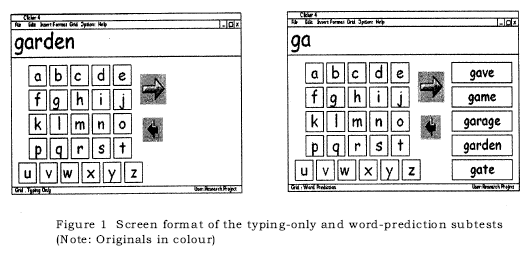
The word-prediction programme used was Penfriend W3 1.04 (Spooner, 1999). Penfriend is compatible with most word processors, but specifically also with Clicker 4. The window for the list of predicted words can be set to maximise accessibility and readability, as the prediction list can appear in customised Clicker cells. Penfriend is user-friendly for children and uses current advances in word-prediction technology.
Any activity using word-prediction is bound by the word-prediction settings selected and those settings have a significant impact on the functional use and apparent efficacy of the prediction software. Considering the goal of this research — to isolate the impact of spelling ability on word-prediction use for young Grade 4-6 children with spelling difficulties, a set of word-prediction parameters was chosen. Great care was taken to choose settings that reflected 'middle-of-the-road' use of word-prediction. These parameters included window size, orientation, location and word order of prediction lists, vocabulary lists and dictionaries used, frequency and recency features, text entry method, the typing task given, the text being typed, the search strategy taught, use of grammar prediction, space savers and auditory feedback.
The Graded Word Spelling Test was used for identifying children with spelling difficulties, for arranging the sample population into four groups and for correlation analysis on the results of the research tests. The Graded Word Spelling Test tests the spelling of up to 80 single words.
Mouse control was a fundamental requirement in the execution of the research task. Mouse control can be impacted by motor difficulties, visual difficulties and unfamiliarity of use. The Mouse Control Screening served to screen the functional mouse ability of the subjects, and the design of the Mouse Control Screening aimed to cover for all the above requirements of mouse control. The Mouse Control Screening, as designed by the researcher, took the form of timing the subjects as they clicked on a small static icon on the screen (a cat) with the mouse for 30 mouse clicks. All the subjects scored times spread evenly between 34 s and 70 s, except for one who scored 171 s. This subject was disqualified.
The final wordlists compiled after the pilot study are presented in Table 1. As it was very important that the two wordlists used in the study were as equivalent as possible, the researcher drew up wordlists that required the same number of keystrokes to type a word with word-prediction. In addition, the easier and more difficult words, as well as the three unpredicted words included in the lists, were spread evenly throughout the lists.

Procedure
An overview of the test procedure is given in Table 2. The total time required to test each subject was approximately 55 min, including a 10 min break. Verbatim instructions were prepared to guide the researcher through the training of the subject and to increase internal validity. A detailed procedure and record form was available to guide the researcher through the steps of the test procedure, as the steps differed for each of the four groups. The entire test event was recorded on video. All the data collected were entered on an Excel spreadsheet for processing.
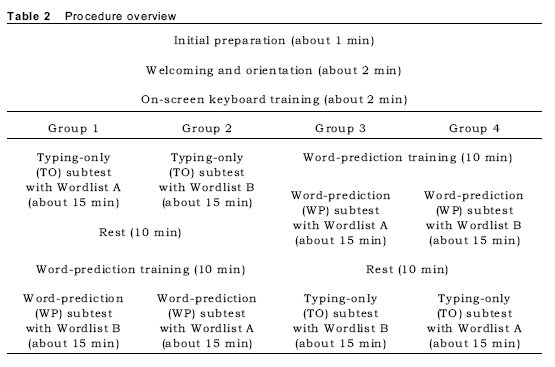
The orientation to the word-prediction subtest was structured and thorough. This was because word-prediction was a new skill that had to be taught before it could be used. It was also an interactive learning experience as choices had to be made throughout the typing of a word. The subject was made aware that the same result of a correctly typed word could be achieved through a few different options. Participants were exposed to a 15-word training session to familiarise them with word-prediction. An additional five very easy-to-spell words served as a test to determine if the children could use word-prediction independently. If they found the predicted word in the prediction list for four out of the five words, they were considered able to use word-prediction. If they were unable to find at least four of the five words, their results would not be used.
Reliability assessment
The entire research task event was video recorded for every subject. The video material was passed on to an independent rater, who was commissioned to watch a random 25% of the videos, analysing and assessing the researcher's administration on the research task. The assessor's task was to check that all units of the procedure had been executed (and in the correct order), time the research test to ascertain accuracy of time scores, note any irregularities in the research protocol and make any other observations deemed relevant. There was a very high degree of consistency between the researcher's and the assessor's timings.
Results and discussion
Table 3 gives an overview of the means, ranges, and standard deviations obtained for the variables investigated. Table 4 indicates correlation scores between the variables investigated. Reference is made to these tables throughout the discussion following.
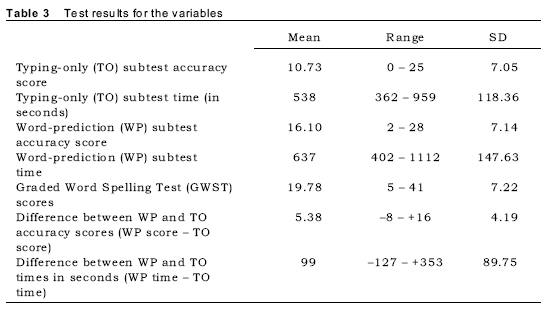
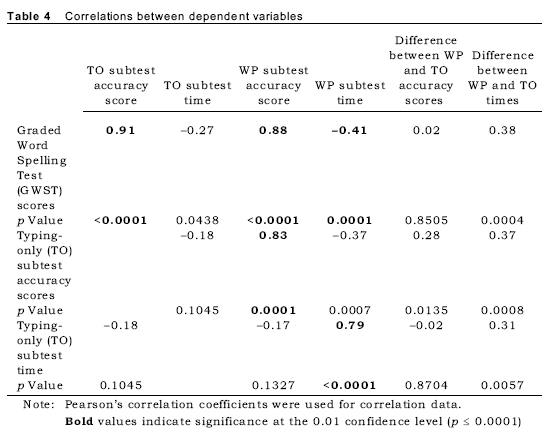
The first aim in this study was to determine whether typing with the use of word-prediction influences spelling scores. The data of all the subjects were sorted in ascending order of typing-only scores. A graph was plotted to compare participants' accuracy scores for typing with and without word-prediction (word-prediction versus typing-only) (Figure 2).
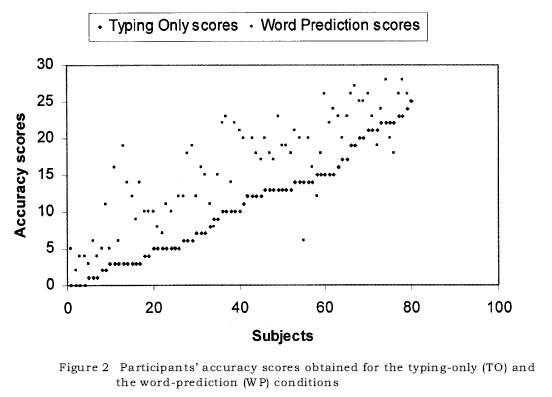
It is evident that for the majority of the participants (89%), word-prediction scores were higher than typing-only scores. This indicated a general improvement across the sample of accuracy scores with the use of word- prediction in the research task. For a few subjects, however, word-prediction can be seen to have had a negative influence on accuracy scores. Typing-only and word-prediction scores had a correlation coefficient of 0.83 (p < 0.0001; see Table 4). As typing-only accuracy scores increased, so did the word-prediction scores.
Whereas the average spelling accuracy score without word-prediction was 10.73 (i.e. mean score) the average spelling accuracy score with word-prediction was 16.10 (see Table 3). The use of word-prediction, therefore, increased the average accuracy scores by 5 correctly spelled words. However, there was a great range in individual responses to word-prediction usage (from -8 to +16 increase in correctly spelled words — see Table 3).
The gains in spelling accuracy scores in the research task suggested that word-prediction could indeed be beneficial in supporting children with spelling difficulties. However, the large variation noted across the subjects' responses is a caution in the decision to introduce word-prediction as writing support for a child with spelling difficulties, without greater awareness of the individual's response to word-prediction. It is therefore advised that decisions to offer word-prediction to children with spelling difficulties should be made on an individual basis, and in conjunction with an evaluation of the individual child's performance using word-prediction.
The second aim in this study was to determine whether the use of word-prediction influenced text entry time. The data of all the subjects were sorted in ascending order of typing-only times. A graph was plotted to illustrate how participants compared in the time they took to type with and without word-prediction (see Figure 3).
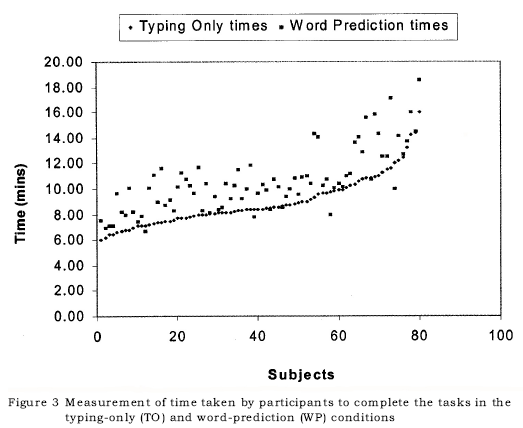
It is evident that for the majority of the subjects (91), word-prediction times were higher than typing-only times, indicating a general increase across the sample of typing time when typing with word-prediction. Typing-only and word-prediction times had a correlation coefficient of 0.79 (p < 0.0001; see Table 4).
From Table 3 it can be seen that the average time to complete the typing-only subtest was 538 s (approximately 9 min), the average time to complete the word-prediction subtest was 637 s (around 11 min). The average increase in time with the use of word-prediction was therefore 99 s (almost 2 min). These results would indicate that time is an important aspect of word-prediction to consider, as potential benefit in terms of accuracy must be measured against the time cost to the participant. The time cost is probably related to the more cognitively demanding process of forming and recognising words in word-prediction use, and may be exacerbated in writing tasks more complex than the single-word spelling task of this project. Across the sample, there was an increase in times from -2 min to +6 min when using word-prediction, indicating that there is great range in individual responses to word-prediction usage with respect to typing times.
The third aim in this study was to investigate whether there was a relationship between spelling knowledge and the influence of word-prediction on spelling accuracy and typing speed. Because the scores obtained on the typing-only condition were used as base scores to establish if word-prediction improved accuracy, these scores needed to be compared to the scores obtained on the Graded Word Spelling Test. The data of all the subjects were sorted in ascending order of Graded Word Spelling Test accuracy scores. A graph was plotted to determine how typing-only accuracy scores related to Graded Word Spelling Test accuracy scores (see Figure 4).
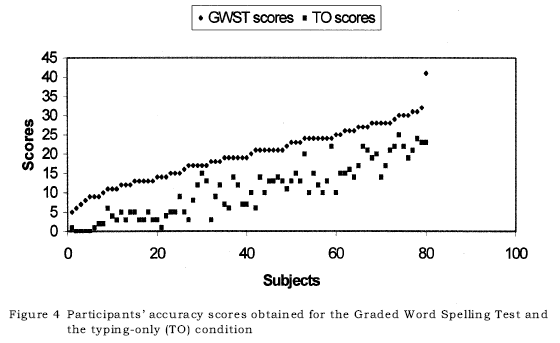
The graph shows that the two tests had a similar distribution of scores across the sample and that it was therefore a reasonable assumption to relate Graded Word Spelling Test accuracy scores to word-prediction scores. From Table 4 it becomes apparent that there was a high correlation between Graded Word Spelling Test accuracy scores and typing-only accuracy scores (0.91, p < 0.0001) and word-prediction (0.88, p < 0.0001) accuracy scores. However, there was no statistically significant correlation between the Graded Word Spelling Test scores and the difference between word-prediction and typing-only scores (r = 0.02, p = 0.8505). It appears then that spelling knowledge did not have a direct correlation with the degree to which a child with spelling difficulties will benefit from word-prediction use. The decision to offer word-prediction to children with spelling difficulties as writing support can therefore not be made on the extent of the spelling difficulty alone. However, there was a moderate correlation (0.38, p < 0.0004) between time benefits and spelling knowledge, indicating a possible decrease in time cost as spelling knowledge increases, possibly due to the positive impact word-prediction would have in increasing the speed at which a child is able to scan through the word-prediction options in order to make a selection.
An additional cost to consider in word-prediction usage was highlighted during the testing, namely, the tendency to make a selection of approximate words. Approximations are words that were chosen by the subjects from the prediction list, and were therefore correctly spelled, but were not the target words the subject was required to spell. The error related to incorrect word recognition. The average number of approximations used across the sample was three. In functional writing and reading, the increase in the number of words correctly spelled when using word-prediction must be measured against the confusion caused by the introduction of correctly spelled, but approximate words, into the text. In written text, an inappropriate word may be even more difficult to read than an incorrectly spelled word.
There was a decrease in the tendency to use approximations as grades increased. Grade 4 children used on average five approximations, the Grade 5s used three, and the Grade 6s used two. A negative correlation between typing-only, word-prediction and Graded Word Spelling Test accuracy scores, and the use of approximations, suggests that the higher subjects scored on typing-only and word-prediction accuracy scores, the less they tended to use approximations. This may have been linked to the progressive spelling maturity of each increasing grade, i.e. as children's spelling knowledge improved, they were less likely to select incorrect words from the prediction list.
Critical evaluation of the study
The cross-over counterbalance design of this study was its primary strength. The design counterbalanced the threats to the internal validity of the study caused by the interaction of the various aspects of the design (DePoy & Gitlin, 1994).
The wordlists appeared to satisfy the requirements of providing a spelling list for the main study that accurately assessed single-word spelling, with accuracy scores over a wide range of scores. The high correlation between the Graded Word Spelling Test and the Typing-only subtests showed that the wordlists were appropriate. That the four sample groups had a high level of equality with respect to the subject characteristics was a good foundation upon which to analyse the results after testing. The sample size of 80 subjects was also a positive feature of the study. The word-prediction training programme that was designed to familiarise the children with the principles of word-prediction appeared to be adequate and suitable. Not one child failed the five-word test given to the children after the training. This also indicated that young children, even those with severe spelling difficulties, could potentially use word-prediction. The task that the children were required to execute proceeded without difficulties. All the logistical flaws of the task had been highlighted and dealt with during the pilot study. The results of this study were able to provide clear answers to the research questions. The impact of approximations, not met in the literature, was presented.
There were some features of the research design which probably negatively influenced the results, thereby underestimating the potential benefit that word-prediction might have in improving the spelling accuracy of children with spelling difficulties in typical usage of word-prediction software. Many of the accuracy and speed enhancing features of word-prediction software were not utilised in this study. It is also important to note that the task did not allow for access to some of the features of word-prediction that the literature has shown could positively influence accuracy scores, such as speech output, frequency adjustments, text specific vocabulary, automatic learning of vocabulary, grammar prediction, and automatic space savers (e.g. keystroke reduction is usually about 50% but in this study was only 32%). The literature pointed out the positive influence of training in, and practice with, word-prediction, thereby increasing the influence that word-prediction could have on improving spelling even further. The subjects in this study had only rudimentary training and practice in word-prediction use. The research project design did not include practice beyond a 10-minute training session. The modest improvements in word-prediction usage in the research project could translate into significant improvements with more training and practice, with respect to both spelling accuracy and speed. There is also sufficient evidence to hope that the frequent, guided use of word-prediction could serve to develop the writing capabilities of the user.
The single-word format of the research task was a limitation to the study. The accuracy improvements and speed enhancements with the use of word-prediction seen in single word spelling in this study may not be realised in functional writing. Another limitation to the study was the Graded Word Spelling Test which was used to determine the spelling knowledge and ability of the children, as it was limited in its effectiveness as a tool for assessment, being a British test and standardised to the British population and British educational system. Also, its age-norms were difficult to apply due to the large difference in school-starting age between British and South African children. However, the Graded Word Spelling Test appeared to be the most suitable alternative available to South Africans. The high correlation between the Graded Word Spelling Test and the typing-only subtest compensated for the weaknesses of the Graded Word Spelling Test.
The pedagogical implications of this study relate to the use of technology to support educational challenges in the classroom. Although the use of technology in education in South Africa is a significant financial, logistic, and expertise challenge that is difficult to overcome and, at this stage, accessible only to a small minority, inclusion of students with special needs into the educational system is firmly placed in the constitution and will rapidly become a reality that teachers will have to be equipped for. The use of computers to support learners in general and software, such as word-prediction, may soon become a recognised and wide-spread educational tool.
Recommendations for further research
Research that investigates the improvements in spelling accuracy with the use of word-prediction across tasks other than single-word tasks, such as copying, dictation, formal sentence construction in class worksheets and free writing tasks, would lead to a clearer understanding of the efficacy of word-prediction. An investigation into improvements in spelling accuracy with the use of word-prediction after more extensive training and practice would be valuable for practical application of word-prediction as an educational tool to support writing where there are spelling difficulties. Understanding the influence of cognition and chronological age on the benefit that word-prediction may be able to offer children with spelling difficulties would add to the understanding of which children would benefit from word-prediction. As this study investigated the relationship between spelling skills and effective word-prediction, a similar study could investigate the relationship between reading skills and word-prediction efficacy. An investigation into the impact of approximations in the use of word-prediction may be useful in understanding how spelling knowledge relates to effective word selection from the prediction lists.
Conclusion
Word-prediction has been shown to be a potentially useful tool in supporting children with spelling difficulties to spell more accurately, despite the costs associated with its use. However, the response of an individual with spelling difficulties to word-prediction usage varies and is difficult to predict. The results of this research project may serve as additional information in facilitating decisions regarding the use of word-prediction in the context of special education.
References
Allred RA 1990. Gender differences in spelling achievement in Grades 1 through 6. Journal of Educational Research, 83:187-193. [ Links ]
Anson D 1993. The effect of word-prediction on typing speed. The American Journal of Occupational Therapy, 47:1039-1042. [ Links ]
Berninger VW 2000. Development of language by hand and its connections with language by ear, mouth, and eye. Topics in Language Disorders, 20:65-84. [ Links ]
Crick J 2000. Clicker 4 User Guide. Northampton: Crick Software Ltd. [ Links ]
DePoy E & Gitlin LN 1994. Introduction to research. Multiple strategies for health and human services. St Louis: Mosby-Year Book, Inc. [ Links ]
Ganske K 1999. The Developmental Spelling Analysis: A measure of orthographic knowledge. Educational Assessment, 6:41-70. [ Links ]
Gillette Y & Hoffman JL 1995. Getting to word-prediction: Developmental literacy and AAC. Proceedings of the Tenth Annual International Conference, Technology and Persons with Disabilities. [ Links ]
Herold M 2004. The use of word-prediction as a tool to accelerate the typing speed and increase the spelling accuracy of primary school children with spelling difficulties. MAAC dissertation. Pretoria: University of Pretoria. [ Links ]
Horstmann KH & Levine 1992. Modeling AAC user performance: Response to Newell, Arnott, and Waller 1990. Augmentative and Alternative Communication, 8:92-97. [ Links ]
Klund J & Novak M 1995. If word-prediction can help, which programme do you choose? Closing the Gap Conference. [ Links ]
Koester HH & Levine SP 1998. Model simulations of user performance. Augmentative and Alternative Communication, 14:25-35. [ Links ]
Lloyd LL, Fuller DR & Arvidson H 1997. Augmentative and alternative communication: A handbook of principles and practices. Needham Heights: Allyn and Bacon. [ Links ]
MacArthur CA 1999. Overcoming barriers to writing: Computer support for basic skills. Reading and Writing Quarterly, 15:169-192. [ Links ]
MacMillan JH & Schumacher S 2001. Descriptive statistics. Research in Education: A Conceptual Introduction, 5th edn. New York: Longman. [ Links ]
Newell AF, Arnott J & Waller A 1992. On the validity of user modelling in AAC: Comments on Horstman and Levine 1992. Augmentative and Alternative Communication, 8:89-92. [ Links ]
Newell AF, Booth L, Arnott J & Beattie W 1992. Increasing literacy levels by the use of linguistic prediction. Child Language Teaching and Therapy, 138-156. [ Links ]
Shanahan T & Lomax RG 1986. An analysis and comparison of theoretical models of the reading-writing relationship. Journal of Educational Psychology, 78:116-123. [ Links ]
Spooner R 1999. Penfriend for Windows. Edinburgh: Penfriend Ltd. [ Links ]
Szeto AL, Allen EJ & Littrell MC 1993. Comparison of speed and accuracy for selected electronic communication devices and input methods. Alternative and Augmentative Communication, 9: 229-242. [ Links ]
Tam C, Reid D, Naumann S & O'Keefe B 2002. Effects of word-prediction and location of word-prediction list on text entry with children with spina bifida and hydrocephalus. Augmentative and Alternative Communication, 18:147-162. [ Links ]
Van der Leij A & Van Daal VHP 1999. Automatisation aspects of dyslexia: Speed limitations in word identification, sensitivity to increasing task demands, and orthographic compensation. Journal of Learning Disabilities, 32:417-428. [ Links ]
Venkatagiri HS 1994. Effect of window size on rate of communication in a lexical prediction AAC system. Augmentative and Alternative Communication, 10:105-112. [ Links ]
Vernon PE 1998. Graded Word Spelling Test, 2nd edn. London: Hodder & Stoughton Educational. [ Links ]
Williams SC 2002. How speech-feedback and word-prediction software can help students write. Teaching Exceptional Children, 34:72-78. [ Links ]
Zordell J 1990. The use of word-prediction and spelling correction software with mildly handicapped students. Closing The Gap, 9:10-11. [ Links ]














